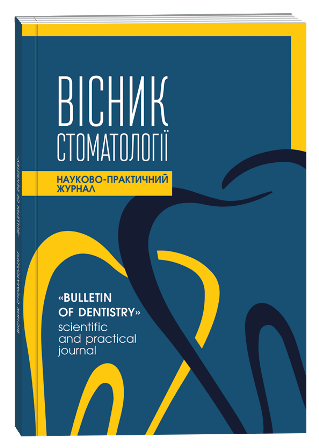РЕЗУЛЬТАТИ КЛІНІЧНОГО ОБСТЕЖЕННЯ ХВОРИХ З ПЕРЕЛОМАМИ ВИРОСТКОВОГО ВІДРОСТКА НИЖНЬОЇ ЩЕЛЕПИ
DOI:
https://doi.org/10.35220/2078-8916-2024-51-1.17Ключові слова:
перелом виросткового відростка нижньої щелепи, комп’ютерна томографія, суб’єктивне та об’єктивне обстеження хворих, вік, стать.Анотація
гностування та дані суб’єктивного і об’єктивного обстеження пацієнтів з переломами виросткового відростка нижньої щелепи в залежності від віку та статі. Методи дослідження. У період проведення дослідження (2022–2023 р.) нами було проведено обстеження 71 пацієнта, віком 20–60 років з переломами виросткового відростка нижньої щелепи (54,93 % осіб чоловічої та 45,07 % жіночої статі), котрі поступили до стаціонарного відділення ОКНП «Чернівецька обласна клінічна лікарня». Клінічне обстеження включало в себе опитування та об’єктивне обстеження пацієнта. Для постановки діагнозу «Перелом виросткового відростка нижньої щелепи» використовували анатомічну класифікацію, запропоновану A. Neff 2014 року і схвалену асоціацією черепно-щелепно- лицьового остеосинтезу (AOCMF). Всім пацієнтам, після суб’єктивного і об’єктивного обстеження, проводилась мультиспіральна комп’ютерна томографія щелепно-лицевої ділянки з подальшою реконструкцію у програмі «Dolphin Imaging». Наукова новизна. Найбільш висока частота переломів виросткового відростка нижньої щелепи (ВВНЩ) визначалась у осіб обох статей у віці 31-50 років, які переважно були отримані внаслідок дорожньо-транспортних пригод та кримінальних дій. Найбільш розповсюдженими об’єктивними симптомами при переломах ВВНЩ були: набряк мʼяких тканин на боці ураження, утруднене відкривання рота та порушення контакту зубів, яке визначалось у 100 % досліджуваних. Найбільш поширеними у пацієнтів були односторонні переломи основи ВВНЩ зі зміщенням фрагментів та односторонні переломи шийки і основи ВВНЩ, які діагностувались з осіб обох статей, у середньому, у 19,72 % та 16,90 % випадків, відповідно. Висновок. Отже, у результаті проведених досліджень доведено, що найбільш схильні до переломів ВВНЩ особи обох статей віком 31-50 років, які були переважно отримані у результаті дорожньо-транспортних пригод та кримінальних дій. У хворих обох статей з найбільшою частотою зустрічалися односторонній перелом основи ВВНЩ зі зміщенням фрагментів: 20,51 % – у чоловіків та 18,75 % у жінок.
Посилання
Boffano P., Roccia F., Zavattero E., Dediol E., Uglešić Vedran et al. European Maxillofacial Trauma (EURMAT) project: a multicentre and prospective study. Journal of cranio-maxillo-facial surgery. 2015. Vol. 43, № 1. P. 62–70. URL: https://doi.org/10.1016/j.jcms.2014.10.011
Аветіков Д. С., Локес К. П., Ставицький С. О. Переломи нижньої щелепи: аналіз частоти виникнення, локалізації та ускладнень. Вісник проблем біології і медицини. 2014. Вип. 3(3). С. 62–64.
Principles of Internal Fixation of the Craniomaxillofacial Skeleton. Trauma and Orthognathic Surgery / eds.: P. N. Manson, J. Prein, M. Ehrenfeld. Stuttgart: Georg Thieme Verlag KG., 2012. doi:10.1055/b-0034-84677
Kozakiewicz M., Zieliński R., Konieczny B., Krasowski M., Okulski J. Open Rigid Internal Fixation of Low-Neck Condylar Fractures of the Mandible: Mechanical Comparison of 16 Plate Designs. Materials (Basel, Switzerland). 2020. Vol. 13, Iss. 8. P. 1953. doi: https://doi.org/10.3390/ma13081953
Munante-Cardenas J. L., Facchina Nunes P. H., Passeri L. A. Etiology, treatment, and complications of mandibular fractures. The Journal of craniofacial surgery. 2015. Vol. 26, № 3. P. 611–615 doi.org/10.1097/ SCS.0000000000001273
Копчак А. В. Порівняльна оцінка способів остеосинтезу виросткового відростку нижньої щелепи при його травматичних переломах. Acta Medica Leopoliensia. 2014. Т. 20, № 2. С. 9–17.
Kostakis G., Stathopoulos P., Dais P., Gkinis G., Igoumenakis D. et al. An epidemiologic analysis of 1,142 maxillofacial fractures and concomitant injuries. Oral surgery, oral medicine, oral pathology and oral radiology.2012. Vol. 114, 5 Suppl. P. S69–S73 doi. org/10.1016/j.tripleo.2011.08.029.
Juncar M., Tent P. A., Juncar R. I., Harangus A., Mircea R. An epidemiological analysis of maxillofacial fractures: a 10-year cross-sectional cohort retrospective study of 1007 patients. BMC oral health. 2021. Vol. 21, № 1. P. 128 doi.org/10.1186/s12903-021-01503-5. 9. Chatterjee A., Gunashekhar S., Karthic R., Karthika S., Edsor E., Nair R. U Comparison of Single Versus Two Non-Compression Miniplates in the Management of Unfavourable Angle Fracture of the Mandible Orginal Research. Journal of pharmacy & bioallied sciences. 2023. Vol. 15, (Suppl 1). P. S486–S489 doi: https://doi. org/10.4103/jpbs.jpbs_555_22.
Odom E. B., Snyder-Warwick A. K. Mandible Fracture Complications and Infection: The Influence of Demographics and Modifiable Factors. Plastic and reconstructive surgery. 2016. Vol. 138, № 2. P. 282e–289e
Хірургічна стоматологія та щелепно-лицева хірургія : у 2 т. Т. 1 : підручник для студентів вищих мед. навч. закл. ІІІ-ІV рівнів акредитації / В. О. Маланчук та ін. Київ: Логос, 2011. 672 с.
Cillo J. E. Jr, Ellis E. 3rd. Management of bilateral mandibular angle fractures with combined rigid and nonrigid fixation. Journal of oral and maxillofacial surgery. 2014. Vol. 72. P. 106–111 doi.org/10.1016/j. joms.2013.07.008.
Грузєва Т.С. Біостатистика. Вінниця : Нова книга, 2020. 384 с.









